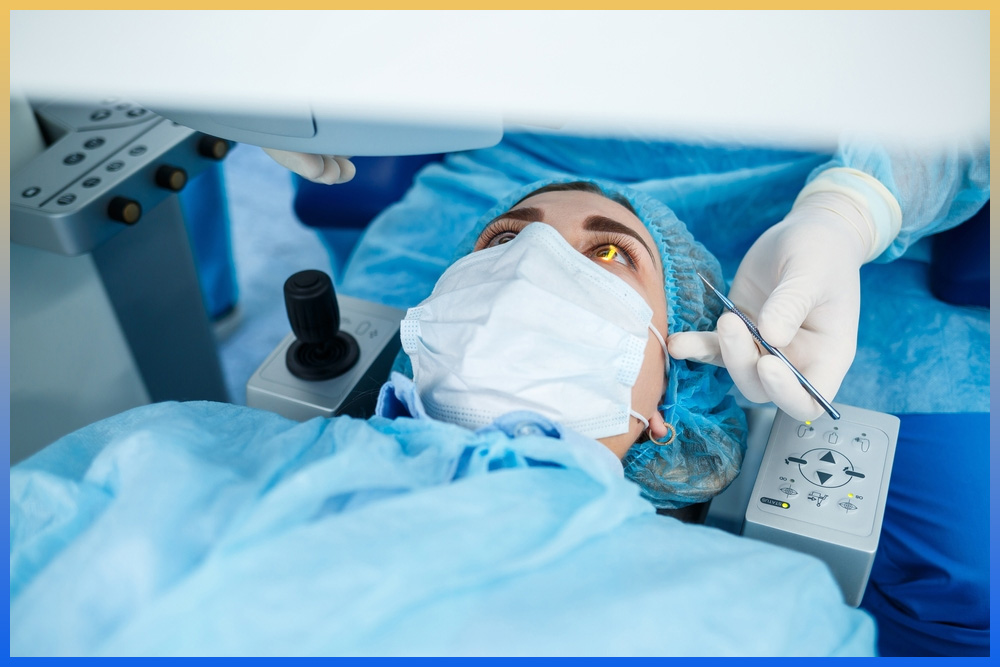PRK in Turkey is the most prevalent vision repair procedure for people that come to Turkey for eye surgeries. In minutes, you will be free of your glasses or contact lenses thanks to PRK Laser Eye Surgery. The PRK Laser technology claims to improve your vision practically indefinitely and painlessly. Furthermore, PRK laser treatment is the most traditional type of excimer laser treatment.
Turkey is an excellent choice for PRK laser treatment. Because both the price and the quality are excellent. In this regard, it is the best choice for you.
The average cost of PRK in Turkey starts from 1.400 USD (1.140£) which is the most affordable price compared to the other European countries. We are doing PRK in Istanbul, Antalya and Izmir, you can choose the best option for you.
Here you can find out and discover more information about the PRK journey in Turkey. Check all the details about PRK costs, our clinic’s patients reviews, before&after photos from the best doctors, all-inclusive packages for PRK in Turkey.
You can get in touch with us for PRK in Turkey via WhatsApp or options below.

GET FREE CONSULTATION
Table of Contents
What exactly is PRK?
Many people find it difficult to function without glasses or contact lenses. Even if you don’t realize they’re on your face, your glasses create headaches from time to time. Waking up and being unable to see anything can often be discouraging. If you wear contact lenses, you must always have a pair on hand, in addition to your contact lens solution.
It is not possible to stay over at your friends’ houses on the spur of the moment if you do not bring them with you. However, there is a procedure that will free you from your glasses, and it has been used for years.
Despite the fact that new treatments exist, PRK surgery is acknowledged to be less expensive than other methods. It is not the sole reason it is preferred; specific medical problems may induce surgeons to prefer PRK over other procedures since the dangers are lower for those diseases.
Lasek works on the premise of eliminating epithelial tissue from the eye using alcohol. The epithelium returns to its original position when the laser is administered. Although these two surface procedures produce safe results, patients may feel burning, stinging, and wetness for 2-3 days. On average, vision improves in 1 week to 10 days.
How to Make PRK?
The uppermost epithelium layer of the cornea, which is the layer on which the laser is placed, is softened, and removed from the upper section of the cornea in the PRK procedure.
This cell layer acts as a shield, shielding the cornea from outside effects. The stroma layer, which is the primary tissue of the cornea, is located just under the cell layer. The laser technique is used on the stroma layer here.
The cornea is sculpted, and the refractive power is altered via laser treatment to the stroma layer. This PRK laser procedure is completed in seconds.
A contact lens is inserted in the patient’s eye before the operation is completed. In roughly 2-3 days, the cell layer removed at the start of the surgery divides rapidly and closes the excised open area. 4-5. On days, the patient is summoned for control, and the protective contact lens is removed from the patient’s eye.
After
A bandage lens will be placed over each eye to protect and repair it. After the procedure, you will be transported to a recovery room and asked to relax for a short length of time.
During this period, your surgeon may do some eye tests to ensure that the surgery went as intended. You will be given anti-pain medicine as well as topical antibiotics to apply to your eyes in order to avoid infection and maintain them clean.
Your surgeon will provide you with post-operative care recommendations that you must follow to ensure a smooth recovery from PRK surgery. You will not be able to drive shortly after surgery, so you must find other transportation home.
In the week following the treatment, you will need to see your surgeon for a follow-up appointment. During this session, your surgeon will check on you’re healing and ensure that you are happy with the results of the surgery.
Our Clinic in Istanbul, Turkey
What are the PRK Risks?
It includes some potential risks.
- Under corrections, overcorrections, and induced astigmatism are all possibilities. Following laser lens reshaping, there may be insufficient central focusing. Most surgeons seek for under corrections at its worst because they can be corrected with an enhancement months later.
- Overcorrections are now more complicated and can cause more eye strain, but they are treatable. Although induced astigmatism is treatable, you might well experience eye strain while an eye heals following the first procedure. Typically, these issues arise as a result of surgeon misjudgements when programming the lasers, an inadequate surgeries plan, or difficulties focusing the laser during the surgery, which could be due to either a surgeon or a device error.
- Stromal haze with reticular haze: This pattern may appear following surgery on the anterior (front) parenchyma, and it is unknown why the layers of the eye develop haze, making it difficult to predict and stop. However, because it rarely affects acuity after PRK, it is only a serious complication if it results in visual impairment.
- Intraocular pressure has risen (IOP): This is usually associated with the use of steroids following the operation. When a person stops taking steroids to treat other surgical issues, their IOP usually returns to normal. Unless steroids were used, there have been no reports of chronic progressive IOP associated with PRK.
- Cataracts of the posterior capsule. This type of eye diseases develops on the underside of the lens capsule and is one of the more major symptoms after laser-assisted surgeries, including PRK. It is most commonly associated with the use of dexamethasone phosphate after PRK in patients.
- You have a very low risk of infection after PRK if you follow your surgeon’s instructions. However, because the cornea has now been impacted and you have open areas, you are at a low risk of developing an eye infection.
Should it be Done in Turkey or in the UK?
The average cost of PRK surgery in the UK is around £1,780 per eye, though prices vary depending on clinic. There aren’t many facilities in the UK that provide this treatment right now. This is because surgeons favour newer and more technologically advanced kinds of laser eye surgery, such as LASIK eye surgery, due to their reduced recovery period.
Nonetheless, the chart below indicates the cost of PRK surgery from some of the most reputable eye surgery clinics: It is not a very healthy situation for you to have your surgery there, as the UK has not developed much in this regard.
We think that you should entrust your eye health to specialists who know their job well. Are we wrong? Therefore, it would be better for you to choose Turkey, where all its doctors are experts.
Why is Turkey More Affordable for PRK?
The cost of PRK varies based on the eye surgeons and hospital’s experience. Furthermore, the cost changes when there are other charges such as lodging, transportation, or if the patient is having eye laser surgery for the second time.
Most people prefer PRK surgery because it is less expensive than other techniques of excimer laser surgery. The cost of PRK surgery is low since you will have better eyesight and will no longer need to buy glasses or contacts.
Your health insurance does not cover eyesight corrective surgery. If you cannot afford surgery in the UK, you may choose to consider having it done in another country where the cost is lower. Because the doctors and hospitals in Turkey are highly experienced, individuals from all over the world travel there to have surgery.
As in every surgery, Turkey is more affordable in this surgery compared to the countries abroad. There is only one reason for this and that is today’s economy.
PRK Reviews in Turkey





Reference:
Ambrósio, R., & Wilson, S. E. (2003, January). LASIK vs LASEK vs PRK: advantages and indications. In Seminars in ophthalmology (Vol. 18, No. 1, pp. 2-10). Taylor & Francis.






